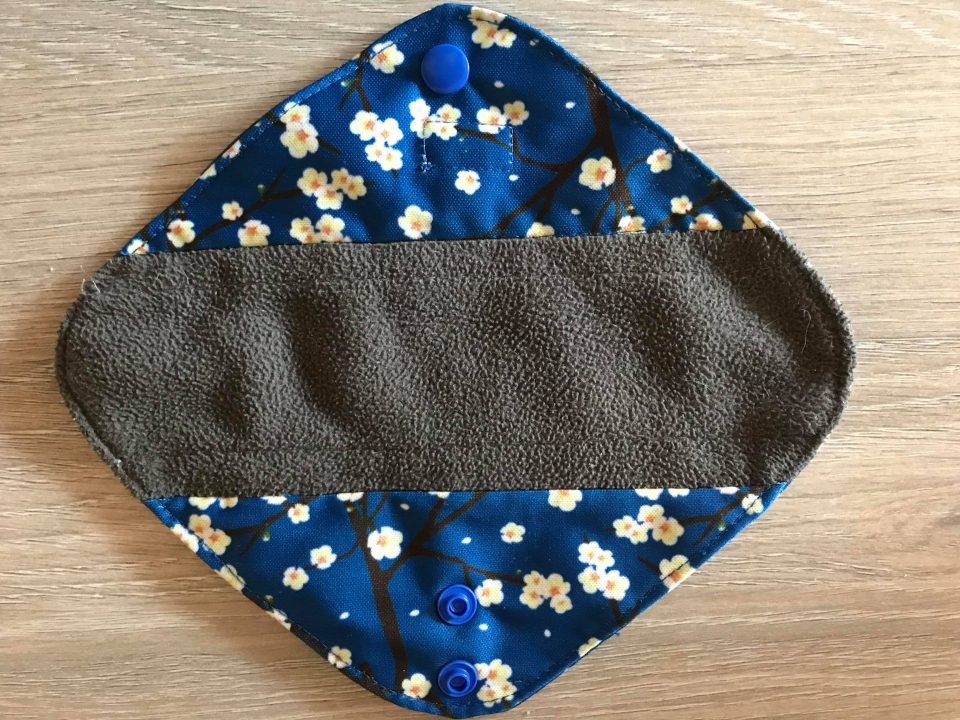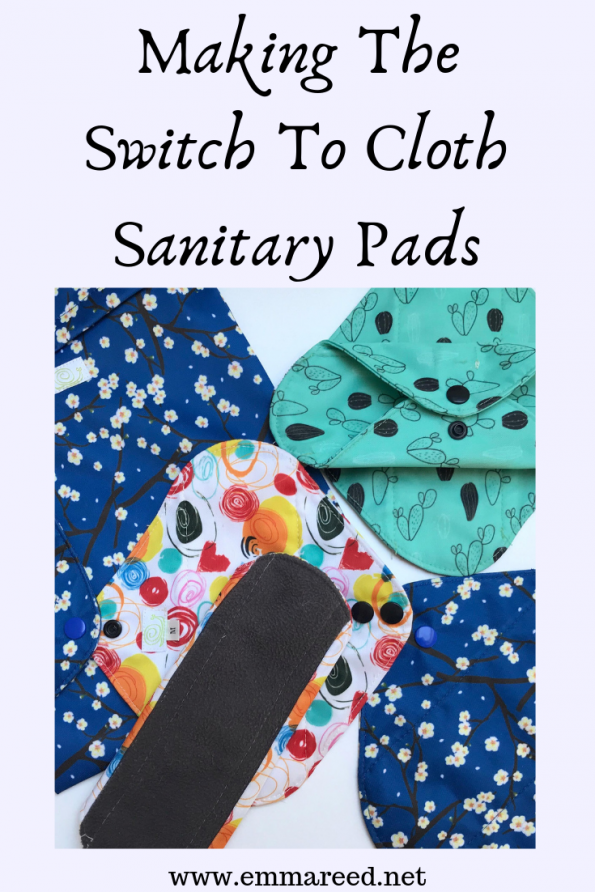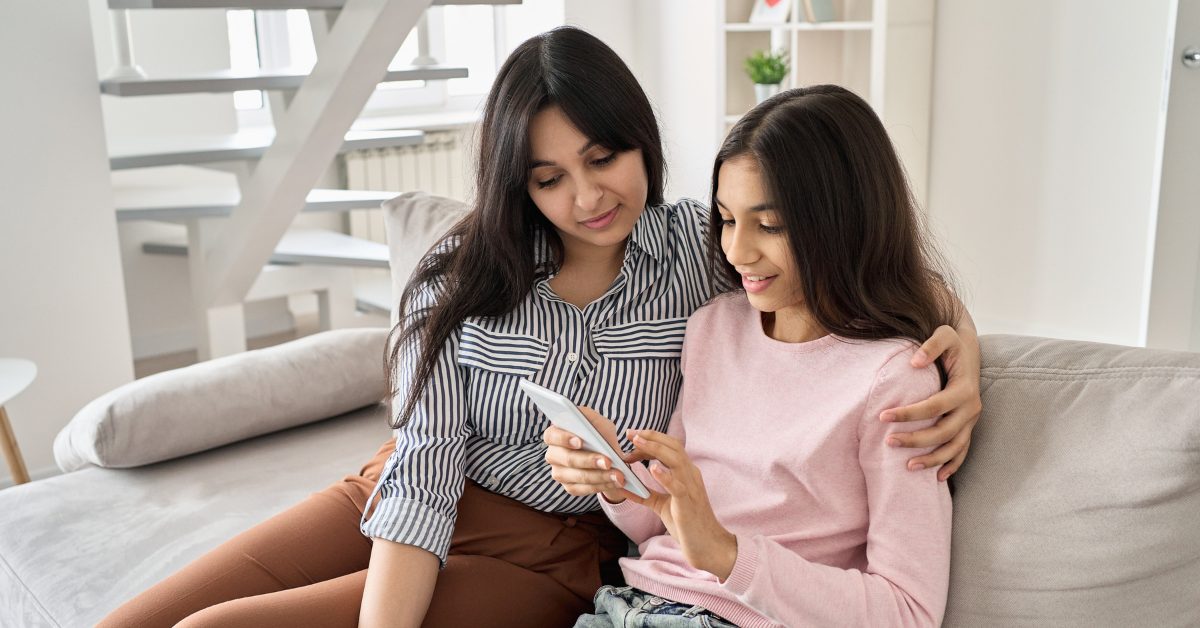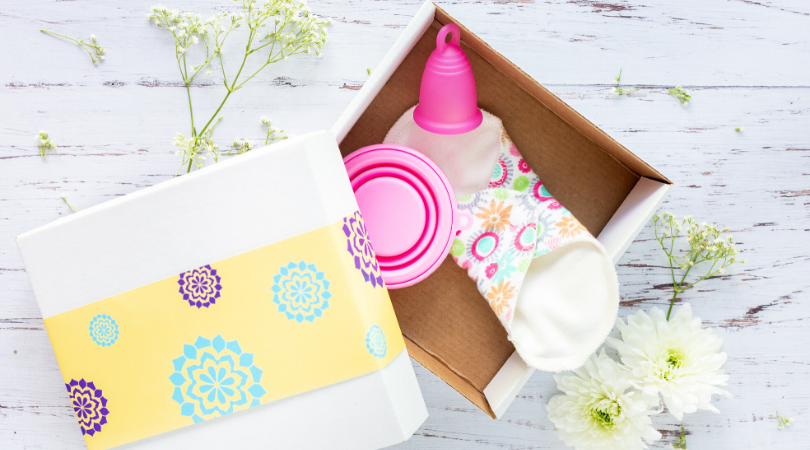
Making The Switch To Cloth Sanitary Pads

I started my periods way back when I was around 11/12 and yet what has recently astounded me is that I have gone around for the last 25 years or so not knowing that cloth sanitary pads were a thing. I have spent how much?! Oh, god, I don’t want to know, just imagine… I may cry, I may actually cry, PLUS I have sent god knows how much plastic, chemical-filled waste to landfill or incineration (pass the bucket). I honestly not only feel sick from all of this but I also feel completely and utterly cheated.
I mean, I learnt from my Mum and from adverts that when you have a period you either go for disposable sanitary towels/pads or tampons. That was it. I was never given any other options, oh except that when you are caught out, toilet roll folded over several times worked until you could get your hands on some products.
So, how on earth did this happen?
Well, after a quick Google I actually discovered that disposable pads aren’t a new thing, nope they were actually invented around 1888. I was really surprised by this, I honestly assumed they would have come about in the ’40s or ’50s. So there we have it, we’ve been merrily discarding our bloody periodness for many a moon but it wasn’t until much later on in the 1980s that we began to add the sticky strip, the plastic, the perfumes and chemicals to draw the blood out and that is a far more important point as these modern-day sanitary pads are contributing to our huge waste and plastic problem.
Want to know how long it will take a pad to decompose? 500-800 years! So, basically we have mini disposable nappies on our hands, don’t we? And yet, I don’t think many of us have thought of them in that way. They have been a necessity, a medical (?) product, a lifesaver and most of us did not know that there were any other options for us. We all thought we were doomed to spend the rest of our lives (almost) spending out all of this money each and every month for a product that we use for just a few hours and then toss into the bin.
How Much Money Exactly?
I again did some googling and just on sanitary products, an average woman will spend around £4,800 in her lifetime. However, I am not sure about this whole ‘average’ thing here as each woman can vary so much and I know of a lot of women who have extremely heavy and painful periods which not only means that they will go through more sanitary pads but they will also be spending out on more pain relief.
So, What Other Options Are There?
I’m so glad you asked. Cloth sanitary pads or CSP as they are fondly known are our best option as they are eco-friendly, gentle on your skin, extremely absorbent plus they will save you a small fortune as well as help making a big difference to our environment. Of course, there is also the menstrual cup which replaces the tampon and period pants but today I am only covering my switch to cloth sanitary pads. For more on other reusable menstrual options check out this blog on plastic-free periods.


What Are Cloth Sanitary Pads Made From?
Most cloth sanitary pads are made from breathable materials such as bamboo, cotton and fleece with absorbent liners made from charcoal and microfibre. They are therefore easy to wash and dry and can be used time and time again.
How Do Cloth Sanitary Pads Work?
The cloth pads are slim, pretty, lined with gorgeous soft materials and simply do up with poppers. You place them onto your knickers and choose from 2 sizes to popper up. I have found which poppers I use really just depends on what style of knickers I go for. The liner absorbs the blood and wicks it away from your skin to help you to feel dry and comfortable.

Are Cloth Sanitary Pads Thicker Than Disposables?
Not at all. They are very thin, very discreet and contain no bulky padding like disposables do.

How I Found The Switch to Cloth Sanitary Pads
I learnt about cloth sanitary pads last year when I was researching using cloth nappies and wipes. I was eager to be able to make as many eco-friendly swaps as I could and these seemed like a natural step for me once my periods returned. I initially bought 4 pads and a wetbag to see how I got on. Like with anything new you need some time to a) get your head around the change b) find a routine that works for you c) find a product that works and d) work out how much you will need.
I must admit that to begin with I found it all very alien. I was used to having this white pad inside my knickers and being able to see what we all think is a huge amount of blood coming out of us. We associate this with having a heavy period and I now realise that this isn’t the case at all. Do you remember being told at school that most women lose around 1 teaspoon a day? A teaspoon? We all gasped! There’s no way that is true! But the reason for us doubting this is down to the chemicals used in disposable pads which draw the blood out and this is also now claimed by some people as adding to those menstrual cramps. When you switch to cloth sanitary pads the first scary thing is that the lining is black. I couldn’t get my head around not being able to see the blood and therefore worrying that I wouldn’t know when to change the pad. BUT the next thing I quickly realised was how much drier I was, how little blood there seemed to be and how much longer a pad could last me. The proof that we don’t actually bleed as heavy as we have always thought.
I can be honest here because let’s face it, we are talking about a topic that has been a taboo for far too long and well I have already used words like bloody periodness, haven’t I?! I have always had a heavy period. I have lost large clots, I used to feel these working their way down when I was a teenager and in my 20’s and I have often leaked at night. My periods did change after having my first child and they seem to have changed again with my second– although I am still breastfeeding so I am sure there will be more change to come. So, to suddenly have so little blood and no mess has been a complete game-changer.

Any Issues?
The only issues I have had is a bit of movement of the pad which I actually realised was because I had it poppered on too tight and it was twisting. My other issue was not realising I needed to change it because I was still trying to get used to not seeing or feeling the blood and it leaked through the other side to my knickers. However, the last point just goes to show that they truly do work. With disposables, I would often feel wet and uncomfortable and be worried that I would leak out of the sides but with cloth I haven’t felt any of this once.
How About Smells?
This is something I think we have all been made to think about over the years. The ads for disposables with perfumes added in, panty liners to keep you ‘fresh’, washes to take away any odours, creams to combat vaginal issues. You never see any products for men to keep their ‘areas’ flowery fresh, do you? We have become accustomed to thinking that we just smell down there and it can be a hugely worrying time during your period, especially as a young girl. God, I remember thinking that people would know I was on my period, I worried they would be able to smell something yucky and I thought the blood was dirty. Luckily, we have come a long way since the ’90s and periods are thought of a lot differently now but the smell or stay fresh thing is still talked about during adverts which really needs to change.
I have had no smells since the swap to cloth and I truly believe that any previous smells were coming from the bleach, chemicals and perfumes placed inside the disposable pads. I have felt fresh without the need for a ‘wash’, I have not suffered from any overheating or itching and I have heard a lot of women say that they no longer get thrush during their period since they have swapped.
So the answer is no smells, no worries and naturally fresh!
Washing Cloth Sanitary Pads
Is this the big question for you? It usually is with cloth nappies so I would imagine washing your own period blood out will bring just as many questions and adversaries.
As I am already in a great routine of washing out cloth nappies, the cloth sanitary pads didn’t bother me whatsoever but I can completely understand if this would you. Some people hate having periods and some struggle to see the blood and touch the pads so I do get that this swap may not be for everyone or that it may be something that you’ll need to get your head around.
When I have used a cloth pad I hand rinse it under cold water to help prevent stains. I am rinsing away as much blood as I can because it isn’t going to go on a wash immediately and sitting with blood on it will cause staining problems. It can then go into a wetbag and wait to be washed. I have washed mine with clothing as I don’t see an issue with that because the machine will do its job, it will wash away any mess and take it away and let’s face it, we all put blood marked knickers in if we’ve had a leak, don’t we? If you don’t fancy this though, just bulk up the wash with towels. Most cloth sanitary pads will state that they need to be washed at 30° and again this is so that they don’t stain, however, I have put mine on 40° and so far I haven’t had any problems.
They dry extremely fast which is helpful if you don’t have a large number of them and if you need a replacement quite quickly.
Overall Thoughts
I am completely converted. There is no way I would go back to disposable pads and there is no reason for me to. I have lighter periods, less mess, have removed that monthly cost plus the trip to the shop when I run out. I have an eco-friendly product that won’t sit in landfill for up to 800 years and one that is far more comfortable and absorbent oh and did you notice all of the funky designs?!
They are a win-win swap.
Do you use cloth sanitary pads? If not, will you think about making the switch? If you fancy trying to make your own, check out this blog post here.

Pin for later:






This is a really interesting post and I’m so glad you wrote about it! I really have had no clue that these existed! To think of all the money and time we spend on pads/ tampins each month is crazy! I love how you shared how much more natural things are, and in all honesty I wish I’d known about them before! Thank you for sharing 🙂
Nanny M xx
Very informative and I’m almost ready to make the switch! I only have one point that could be a sticking point. How are they with exercise? I can only wear pads, so they need to be up to my high level of training.
Well I have to admit that I don’t actually exercise anymore due to being completely exhausted with the boys but they seem to stay put running around after them and I rarely stop!
I just made the switch and my period is still way too heavy the pads and period pants just can’t keep up. My heaviest period pants I tried on a heavy night and thought it would work overnight. I gave my kids a bath for one hour and the period pants from simply wild (simply Sadie Jane) already leaked in an hour. The underwear, period pants and pads are taking so long to dry. Luckily my ra-el washable pads with snaps can go in the dryer but on low it takes forever and still have to air dry a long time. I’m luckily able to stay at home with my kids but would not have survived two hours for about 5 days going out in the pads and underwear even with a pad put over period underwear it leaked all over day and night. It’s been a seriously expensive switch but feel like it’s worth it and will be teaching my girls about it when appropriate so it’s a good model to set. Seems to be helping with pelvic floor pain and certainly resulted in less itching and sweating when I switched to reusable period pants and pads. It’s costing a fortune and still buying disposable and running out while the others are too wet or soaking to clean. I’m trying and I can so relate to making the switch after so many years I didn’t know much about cloth pads and period pants. I’m happy it’s out there and wish I owned a sewing machine now. Wuka underwear has been my favorite and wild and free pants are too big and they’re okay for light days even though I picked heavy or super heavy pants. Oh and Velcro on the pads wings is something I do not like really irritating, painful, and not fun to wash. Great post! thanks for sharing and I’m encouraged if you could do it then I can eventually handle the laundry, leaks, and layering upon layering.
Layering with pads and pants is a really good idea for those heavy days or until you find a brand that is right for your flow. WUKA is a fab brand and they do a wide range of pants for a variety of flows, I know some people also use a cup with these too. I hope you find a good balance and routine soon with them xx